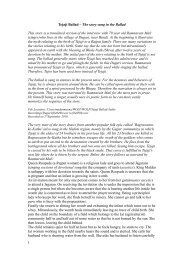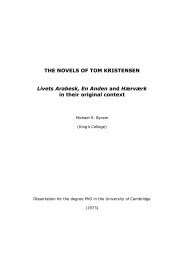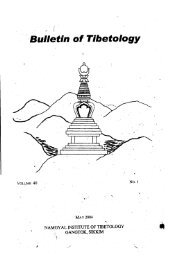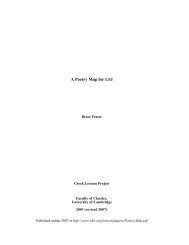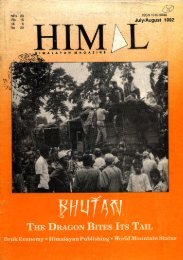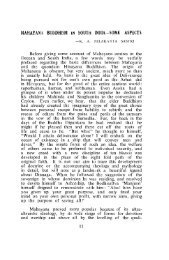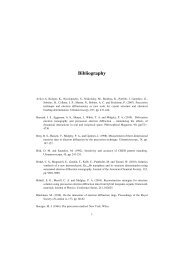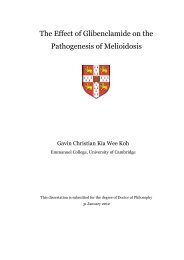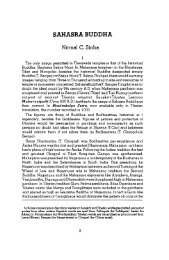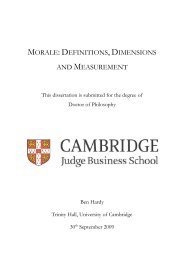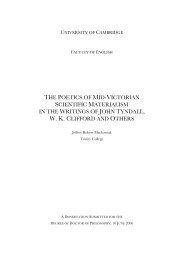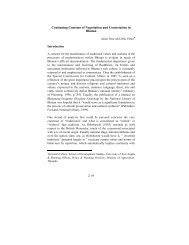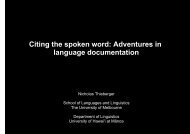The Crusades, the Genoese and the Latin East - DSpace at ...
The Crusades, the Genoese and the Latin East - DSpace at ...
The Crusades, the Genoese and the Latin East - DSpace at ...
Create successful ePaper yourself
Turn your PDF publications into a flip-book with our unique Google optimized e-Paper software.
money or merch<strong>and</strong>ise! <strong>The</strong>se tables are based on <strong>the</strong> cartulary of Giovanni Scriba (1155-64). 9<br />
Recently, S<strong>and</strong>ra Origone followed <strong>the</strong> same methodology in her analysis of <strong>Genoese</strong> commerce<br />
<strong>at</strong> <strong>the</strong> beginning of <strong>the</strong> thirteenth century (1200-3; 1205-16; 1222-7). 10<br />
In <strong>the</strong> same volume, Laura<br />
Balletto produced a similar table for <strong>the</strong> commercial activities in <strong>the</strong> years 1257-8.11 During <strong>the</strong><br />
research for <strong>the</strong> current dissert<strong>at</strong>ion <strong>the</strong>re was an <strong>at</strong>tempt to follow a similar methodology<br />
concerning ventures in <strong>the</strong> year 1191. <strong>The</strong> exercise, however, proved this methodology<br />
insufficient. In th<strong>at</strong> year, 53 contracts were made to Sicily as a first destin<strong>at</strong>ion. A few o<strong>the</strong>r<br />
contracts directed <strong>the</strong> travellers to Naples or Sardinia before <strong>the</strong>y went to Sicily. However, in <strong>the</strong><br />
spring of 1191 most of <strong>the</strong> shipowners <strong>and</strong> travellers did not end <strong>the</strong>ir journeys in Sicily, <strong>the</strong>y<br />
only stopped <strong>the</strong>re to meet up with <strong>the</strong> crusaders. Many were on <strong>the</strong> way to <strong>the</strong> <strong>L<strong>at</strong>in</strong> <strong>East</strong>. It<br />
would have been a mistake to employ <strong>the</strong> traditional analysis in this case. In order to estim<strong>at</strong>e<br />
which ship headed only to Sicily <strong>and</strong> which was to return to Genoa it is possible to use <strong>the</strong> type of<br />
vessel as an indic<strong>at</strong>ion, because only large ships sailed over long distance. Ano<strong>the</strong>r factor th<strong>at</strong><br />
might be misleading is <strong>the</strong> number of contracts made for each destin<strong>at</strong>ion. For various reasons,<br />
different merchants would h<strong>and</strong>le <strong>the</strong>ir business in different manners, some merchants tended to<br />
make separ<strong>at</strong>e contracts with each investor, while o<strong>the</strong>r merchants registered <strong>the</strong>ir agreement with<br />
many partners in one contract. <strong>The</strong>refore, it is more accur<strong>at</strong>e to count <strong>the</strong> number of travellers<br />
who made contracts to each destin<strong>at</strong>ion ra<strong>the</strong>r than <strong>the</strong> total number of contracts. <strong>The</strong>se are only<br />
few examples of how complic<strong>at</strong>ed utilising <strong>the</strong> notarial cartularies as a historical source might be.<br />
<strong>The</strong> d<strong>at</strong>a <strong>the</strong>se documents contain might seem meaningless until a certain arrangement of<br />
<strong>the</strong> documents reveals p<strong>at</strong>terns or <strong>the</strong> break of p<strong>at</strong>terns. <strong>The</strong>re is so vast an array of inform<strong>at</strong>ion,<br />
however, th<strong>at</strong> it is overwhelming too: names, destin<strong>at</strong>ions, merch<strong>and</strong>ise, currencies <strong>and</strong> many<br />
more details. In order to go beyond <strong>the</strong> st<strong>at</strong>istical analysis <strong>the</strong> documents must be rearranged <strong>and</strong><br />
put toge<strong>the</strong>r in a new order th<strong>at</strong> corresponds to <strong>the</strong> topic under discussion. It is difficult to process<br />
this inform<strong>at</strong>ion using traditional methods of historical analysis. But aided by computing software<br />
it is possible to map <strong>the</strong> d<strong>at</strong>a <strong>and</strong> display <strong>the</strong> relevant m<strong>at</strong>erial in a sensible manner. <strong>The</strong><br />
documents were summarised on a large table (Excel spreadsheet) which includes 32 columns<br />
8 Ibid, pp. 58-59; Geo Pistarino, 'Commercio e comunicazioni tra Genova ed it Regno normanno-svevo<br />
all'epoca dei due Guglielmi' in Potere, societä epopolo nell'etä dei due Guglielmi (Bari , 1981), p. 245 (1<br />
would like to thank Prof. Laura Balletto for a copy of this article); David Abulafia, <strong>The</strong> Two Italies:<br />
Economic Rel<strong>at</strong>ions between <strong>the</strong> Norman Kingdom of Sicily <strong>and</strong> <strong>the</strong> Nor<strong>the</strong>rn Communes (Cambridge,<br />
1977) pp. 99,111,113,119; Erik Bach, La Cite de Genes au Me siecle (Kobenhavn, 1955), p. 51.<br />
9 M. Chiaudano <strong>and</strong> M. Moresco (eds. ), 11 cartulare di Giovanni Scriba, 2 vols. (Rome-Turin, 1935).<br />
10 S<strong>and</strong>ra Origone, `Genova, Costantinopoli e it regno di Gerusalemme (prima meta sec. XIII)', in Gabriella<br />
Airaldi <strong>and</strong> Benjamin Z. Kedar, eds., I comuni italiani ne! regno croci<strong>at</strong>o di Gerusalemme (Genoa, 1986),<br />
pi 310.<br />
it Laura Balletto, `Fonti notarili genovesi del secondo Duecento per la storia del Regno <strong>L<strong>at</strong>in</strong>o di<br />
Gerusalemme', Gabriella Airaldi <strong>and</strong> Benjamin Z. Kedar, eds., I comuni italiani ne! regno croci<strong>at</strong>o di<br />
Gerusalemme<br />
(Genoa, 1986), pp. 185-7.<br />
14



